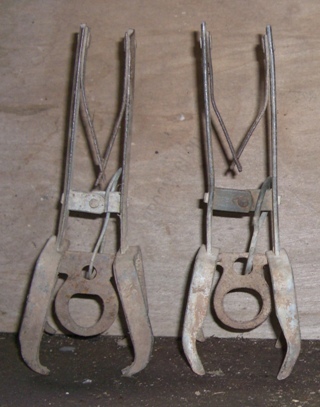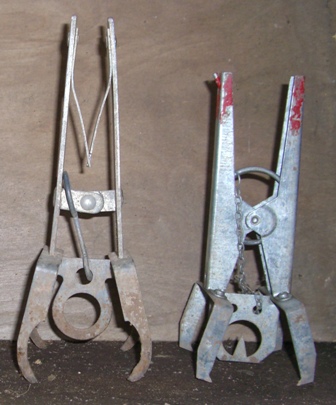|
 |
Quick Instructions
for |
 |
| Setting a Scissor |
| Mole Trap at |
|
Walcote Farm. |
|
A guaranteed way of
catching moles with these types of scissor mole traps. |
|
The John Finnemore method of
setting a scissor mole trap at any depth. |
|
1. Find a mole run with a probe,
between two molehills. The best place is
not where there are new molehills but where the moles return on
their way back for water or shelter. Do not set a trap in a
molehill. |
|
2. Push a trowel into the ground by the probe, Lift
up the turf, just enough to squeeze your hand into the slot, to find the centre and
angle of the mole run. If you find another run branching off, find
another place to set the trap, otherwise remove the soil directly above the run.
|
|
3. If you find the soil very loose,
then widen the hole with your trowel or hands by pushing the soil
sideways without removing soil, to
expose the mole run.
The hole needs to be narrower than the trap if
the ground is soft. Insert the trap into the hole, so it makes
grooves down the sides. Then remove the trap for the next stage of
preparing the hole. |
|
4. If the mole run is wet and sticky, or the
soil is very loose, lower the mole run with a trowel to find firmer
and drier ground. This method will make it easy to compact the mole
run. Remove any loose soil in the hole.
Never compact loose soil. Place the T-handle into the hole to
compact the soil in the run. I will hold the T-handle
at different angles so that all the area in the bottom of the run is
compacted when the end of the T-handle is hit hard with the hammer. The idea of the T-handle is that it can be pushed up the
mole run on either side of the hole so that the approach to the trap
can also be compacted. Compacting the soil also compacts any stones
in the ground and stops them getting caught in the trap. If the trap
is going to be set at a lower level, compact the slope of the mole run on either side of the
trap with a slope. Compacting the soil allows the trap to close
quicker and also makes the mole run smooth, which is essential for
catching moles. Remove more soil from the run if you are not getting
the compaction. |
|
5. Set the trap in the mole run with the trigger ring
¾ of an inch from the
base of the run. You might have
to push the trap into soil at the side of the run, to get the right
height. Keep the mole run smooth with no loose soil on it. |
|
6. Testing the trap. Before you start covering the hole
up, to keep out the light, check to see if the trap is going to
close fast when a mole triggers the trap. This saves a lot of wasted
time in mole catching.
Pinch together the trap handles, just enough for the setting ring to
drop down and then release the trap handles. The trap could close
slowly. Keep putting the trap back in the mole run and keep
repeating the procedure, removing any loose soil, until the trap
closes fast. |
|
7. Carefully lay soft matted grass inside the hole,
(not long seeded grass stems), on top
of the jaws, all around the trap and between the handles. Make sure
that the matted grass does not extend wider than the hole. This
method allows the trap to be set at any depth. Matted
grass can be found where the grass is thicker and is pulled up by
clawing at it, near its roots. |
|
8. Add loose soil, to cover up the matted grass,
after you are sure that the soil will not fall into the mole run, in order
to keep out the light. |
|
50 years of mole catching by John Finnemore, Walcote Farm,
Warwickshire.
www.walcotefarm.co.uk. |